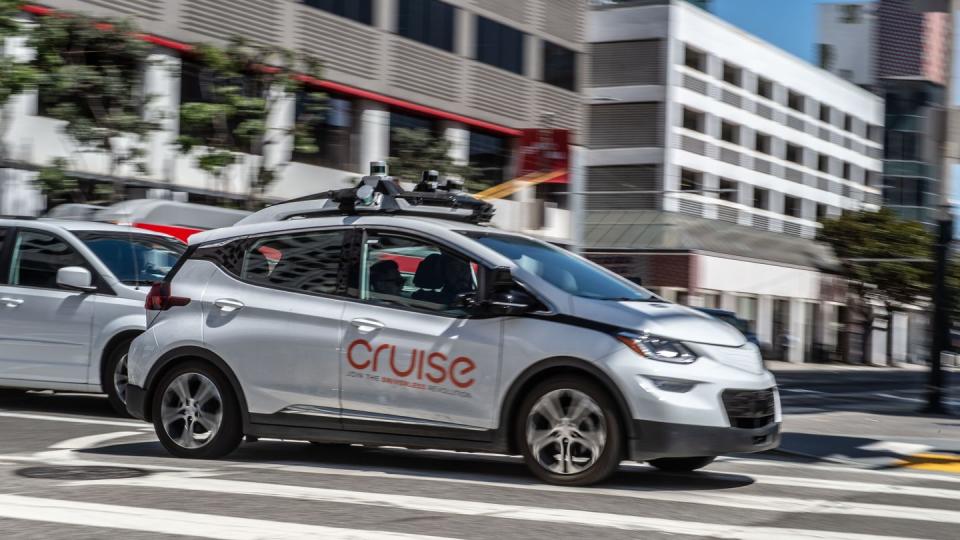Will GM’s Cruise Bounce Back from Latest San Francisco Mishaps?

Shortly after the CPUC’s favorable ruling, about 10 Cruise AVs blocked streets in the North Beach bar and restaurant district, sitting motionless with flashers blinking for about 15 minutes, according to the Los Angeles Times.
“The DMV is in contact with Cruise and law enforcement officials to determine the facts and requested Cruise to immediately reduce its active fleet of operating vehicles by 50% until the investigation is complete,” the DMV told Autoweek.
Cruise’s 3 million miles of testing pale next to Waymo’s 20 million.
Three weeks ago, General Motors’ autonomous-vehicle subsidiary Cruise was on a roll after the California Public Utilities Commission agreed to let the company’s robotaxis, along with Alphabet’s Waymo, charge fares 24/7 in its hometown testbed of San Francisco.
For sure, there had been some high-profile mishaps prior to the CPUC’s ruling, including anonymous prankster-protestor group SafeStreetRebel stopping some AVs in their geo-fenced tracks by “coning” them with pylons.
It is what’s happened since the CPUC’s favorable ruling that has slammed the re-gen brakes—perhaps “lifted accelerator pedal” is more accurate—on Cruise.
The weekend after the CPUC’s ruling, about 10 Cruise AVs blocked two narrow streets in the middle of the North Beach bar and restaurant district, sitting motionless with flashers blinking for about 15 minutes, according to the Los Angeles Times.
Cruise first blamed the mishap on too many cellphone carriers from the nearby Outside Lands music festival, then said it appeared to be intentional pedestrian interference.
Mishaps under Investigation
The next week, another Cruise parked itself in wet cement on a city street. Then, a Cruise robotaxi carrying a passenger collided with a fire truck in a San Francisco intersection.
That Friday, just eight days after the CPUC’s favorable ruling for Cruise and Waymo, Cruise agreed to cut its San Francisco fleet in half while the state’s Department of Motor Vehicles investigates these latest mishaps.
“The DMV is in contact with Cruise and law enforcement officials to determine the facts and requested Cruise to immediately reduce its active fleet of operating vehicles by 50% until the investigation is complete and Cruise takes appropriate corrective actions to improve road safety,” a DMV spokesperson said, via email.
“Cruise has agreed to a 50% reduction and will have no more than 50 driverless vehicles in operation during the day and 150 driverless vehicles in operation at night.”
The DMV granted Cruise and Waymo AV permits in September 2021, a prerequisite for the CPUC to allow the companies to charge fares.
While the state DMV holds up Cruise’s expansion in San Francisco during its investigation, leadership in San Francisco wants to roll back the CPUC’s favorable ruling for Cruise and Waymo.
Local Officials Opposing Unlimited AV Deployment
“The city attorney filed a motion for stay of the CPUC’s decision,” county Board of Supervisors President Aaron Peskin told Autoweek via email. And this month the city “will be filing a request for rehearing of the CPUC’s decision allowing for the unlimited deployment of AVs by Cruise and Waymo.”
Alphabet’s Waymo One AV service has about 250 Jaguar i-Pace robotaxis based in San Francisco and the surrounding Bay Area, not all deployed at the same time. As both Cruise and Waymo One deploy electric vehicles for their autonomous taxis, a portion of each must be recharged and cleaned at any given time, and of course their numbers ebb and flow with demand between peak hours.

 Yahoo Autos
Yahoo Autos 